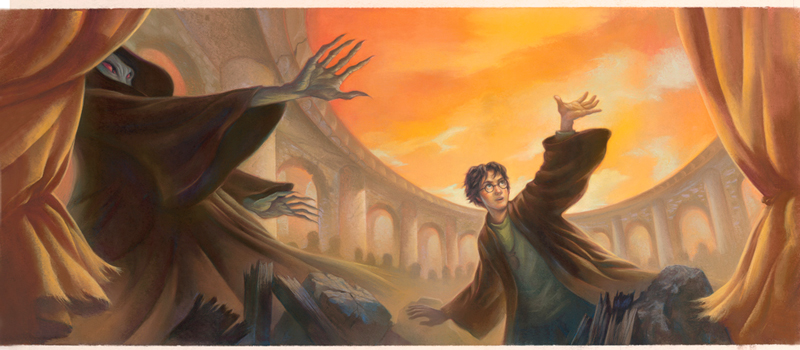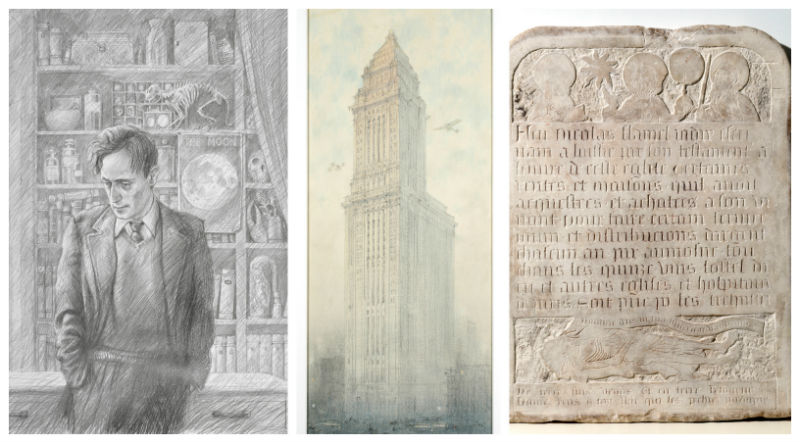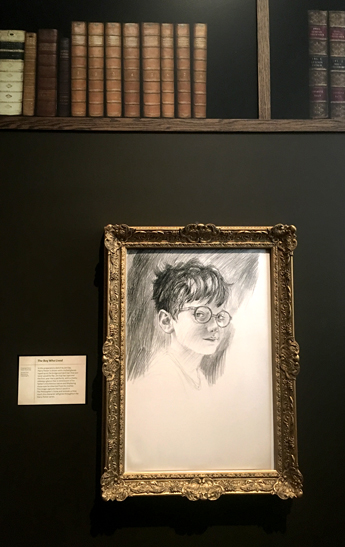British Library Sends "Harry Potter: The History of Magic" to New York
Magic, mythology, astronomy, and J.K. Rowling's beloved universe come together in an exhibit now on display in the United States.
It began as a tentative conversation between the British Library and the U.K. publisher of the Harry Potter series. It was a giant “What if…” that developed into Harry Potter: A History of Magic, an exhibit, that mixes the history and allure of J.K. Rowling’s fictional world with the history of magic, mythology, astronomy, and more.
 |
Jacket art for "Harry Potter and the Deathly Hallows" (U.S. edition) by Mary GrandPré, 2007 |
“The symmetry of the history of magic and the history of Harry Potter work so beautifully and the structure is so clear,” says Jamie Andrews, head of culture and learning at the British Library.
The exhibit opened in London a year ago and became the most successful exhibit in British Library history. Now, as part of Scholastic’s celebration of the 20th anniversary of the first Harry Potter book’s publication in the United States, it has crossed the Atlantic and landed at the New-York Historical Society Museum and Library from Oct. 5 to Jan. 27, 2019. The show immerses fans in their beloved world, with extraordinary historical items that connect to the themes in the fictional narrative.
The British Library worked with J.K. Rowling and her team, as well as the book's U.K. publisher, Bloomsbury, to create Harry Potter: A History of Magic. During the process, exhibit creators found inspiration from one of the books.
“The phrase we kept coming back to was, ‘When in doubt, go to the library,’” says Andrews. “'When in doubt, go to the library.’ The power of that phrase came through during the exhibition, and it’s something we referred to a lot. It’s a central place in Hogwarts story. Exciting things happen; plots advance in the library.”
That idea resonated with exhibit visitors in London, according to messages left on a wall where people are invitied to share their reactions after seeing the show.
 |
From left to right: Portrait of Professor Remus Lupin by Jim Kay, on loan from Bloomsbury Publishing Plc; Cass Gilbert Study for the Woolworth Building New York, 1910 New-York Historical Society Library, Cass Gilbert Architectural Record Collection; Paris tombstone of Nicolas Flamel; Paris, Musée de Cluny—Musée national du Moyen Âge |
“So many people, in so many different languages, latched on to that quote,” says Andrews.
It’s also a quote that curators believe speaks to the organization’s mission and the exhibits goal to reach beyond the world of Harry Potter.
“J.K. Rowling is a great supporter of libraries and literacy,” Andrews says. “We, of course, believe in libraries. The New-York Historical Society Museum and Library. It all connects rather easily. It’s an exhibition about ‘Harry Potter,’ but it’s an exhibition about learning as well. The students go to Hogwarts to learn. They learn about these traditions. We’re a learning organization. It’s just such a happy marriage and mixing of shared enthusiasms and shared passions.”
Harry Potter: A History of Magic has more than 150 items on display, organized around the subjects studied at Hogwarts School of Witchcraft and Wizardry--potions and alchemy, herbology, divination, charms, astronomy, defense against the dark arts, and care of magical creatures.
Most of the original exhibit is now in Manhattan, but some items were swapped out to give the experience a New York twist and to acknowledge the different way Harry Potter exists in American than Great Britain. Tweaking exhibits to fit different audiences is part of what institutions do when lending them to other institutions.
In New York, visitors will see the architect’s sketch of Manhattan’s Woolworth building, which features prominently in the Fantastic Beasts movies. The original costumes from the Cursed Child play in London are also on view, but in New York, there are additional models of the set and theater from the Broadway show.
 |
Pages from Leonardo da Vinci's notebook, circa 1506-8. The notations, written in Italian, in Leonardo's mirror handwriting, reads from right to left. Courtesy of the British Library Board |
Another addition unique to the New York show is impressive to Andrews.
“In London, we featured copy of Audobon’s Birds of America,” he says. “We have one of the original editions, but of course New-York Historical has the original watercolors. So as magnificent as our Birds of America was, when you see the original watercolor of the owl--which connects to Hedwig--that really blows you away.”
In some places, the lines between history and fiction blur even more. Nicolas Flamel, it turns out, was a real person, and his tombstone is on display.
The exhibit has a couple of interactive elements—visitors can tap lights dishes to add ingredients follow a recipe to make a potion, as well as access digital divination cards that reveal past, present, and future. There is also an image of a snitch flitting around the Charms room, disappearing and reappearing along the walls while a circle of brooms hangs overhead. There are also a few videos.
But technology is not the defining element of this show. The items on paper are most meaningful and impressive to fans of Potter and history buffs alike.
 |
A Jim Kay sketch of Harry Potter. |
One of the first things visitors will see is a note written by Alice Newton, the eight-year-old daughter of Bloomsbury Publishing founder and CEO Nigel Newton, who had handed his daughter Rowling’s oft-rejected manuscript of the first book in the series.
“The excitement in this book made me feel warm inside,” Alice wrote in pencil, in the uneven script of an elementary school child. “I think it is possibly one of the best books any 8/9 year old could read”—Alice forgot the period at the end of the sentence, but she helped launch an international phenomenon, so she can be excused.
The show follows a paper trail through history from the last 20 years of Harry Potter to hundreds then thousands of years ago and back to Rowling’s relatively new universe. Annotated pages of Half-Blood Prince show various changes that will delight Potter fans as they see the process that created their favorite books. On one page, “Dammit” is crossed out and, instead, Ron Weasley now says, “Typical.” Suggested cuts are made with long slashes of a pen over multiple paragraphs.
In another room, visitors find Leonardo da Vinci’s notebook from the early 1500s or a Chinese star chart from about 800 years earlier. Then it’s back to Hogwarts, with one of seven handwritten versions of Tales of Beedle the Bard is on display. Throughout the exhibit, Rowling’s sketches are interspersed with the evolving work of illustrator Jim Kay—her early drawings of a map of Hogwart’s and Harry and the Dursleys, his take on Hagrid, Diagon Alley, and house elves.
Those who can’t get to the New York can experience the exhibit through the companion book, which takes readers through the Hogwart’s subjects just as the exhibit does. The book examines the historical artifacts, original material from U.S. publisher Scholastic, Rowling’s personal archive, and the original artwork from Harry Potter series artists Kay, Mary GrandPré, and Brian Selznick.
RELATED
The job outlook in 2030: Librarians will be in demand
The job outlook in 2030: Librarians will be in demand
ALREADY A SUBSCRIBER? LOG IN
We are currently offering this content for free. Sign up now to activate your personal profile, where you can save articles for future viewing






Add Comment :-
Be the first reader to comment.
Comment Policy:
Comment should not be empty !!!